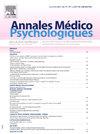Approche historique du trouble déficit de l’attention hyperactivité et de sa prise en charge
IF 0.5
4区 医学
Q4 PSYCHIATRY
引用次数: 0
Abstract
Attention Deficit Hyperactivity Disorder (ADHD) is a neurodevelopmental disorder affecting 5% of children and nearly 3% of adults. This frequent disorder, often associated with comorbidities, is part of a developmental trajectory from childhood to adulthood, and can have repercussions in various areas of individual functioning. We present a non-exhaustive narrative review, focusing on the evolution of the concept of ADHD and its management in children and adolescents. On the 18th century, the first European clinical descriptions, by Melchior A. Wiekard and Cornelius A. Kloekhof and later Alexander Crichton, focus on attention deficit using the term of “attentio volubilis”. A century later, Désiré Magloire Bourneville introduced the concept of “mental instability”; he formalized his models of education and advocated the creation of “special classes” in ordinary schools. By the beginning of the 20th century, Alfred Binet writes “Le portrait de l’instable” (The portrait of the unstable) and already highlights the value of positive reinforcement in the school context. Then, Georges Still, a pediatrician, described the syndrome of “loss of moral control”, in children with no impairment of “general intelligence”, with no identifiable somatic cause; which he associated with “Minimal Brain Damage” referring to minor brain lesions. This theory is taken up in studies on Van Economo-Cruchet encephalitis, which in its hyperkinetic form is similar to ADHD as we know it today. American psychiatrist Charles Bradley publishes his first study on the administration of benzedrine sulfate. Bradley supports a multi-factorial model of behavioural disorders and insists on a global management strategy, combining a psychological and a biological dimension. In 1963, Conners and Eisenberg published the first article on the effect of methylphenidate on children's behaviour and learning. Efficacity of treatements on ADHD symptoms both attested of the neurological underpinnings of this behavioral disorder. Then, two theoretical currents evolved: a neuroanatomical and neurobiological approach on the one hand, and a psychoanalytical current on the other. Polemics about the recognition of the disorder and its causality emerged, contributing to poor identification, delayed access to diagnosis and specific care in France. Wood et al., published a preliminary study on the evolution of “Minimal Brain Dysfunction” in adulthood, representing the beginnings of the developmental perspective of ADHD. Over the last forty years, the contribution of neuroscience (cognition, imaging, electrophysiology, genetics, epigenetics, etc.) has enabled us to develop integrative theoretical models of understanding that describe the complexity of the disorder: a multi-path model was proposed by Sonuga-Barke and Fairchild in 2012. Taken together, these empirical data aim to establish a model for understanding ADHD, and neuroscientists agree that multimodal approaches and “big data” analyses that integrate genetic, imaging and phenotypic data are particularly important for advancing a comprehensive model of understanding, and also for approaching the clinical heterogeneity of this disorder. The international classifications are first clinical categorizations based on predominantly behavioral criteria – initially focusing on inattention (DSM 3), then reintegrating hyperactivity (DSM-3R) introducing the term “attention deficit hyperactivity disorder”, defining ADHD subtypes: inattentive, impulsive/hyperactive, combined (DSM 4). This neuroscientific research has enabled classifications to evolve from a categorical approach to a dimensional and neurodevelopmental approach (DSM-5 and CIM 11), positioning ADHD within a model of etiological understanding. Nowadays, ADHD is the subject of an international consensus statement. The publication of the French 2023–2027 National Strategy for Neurodevelopmental Disorders demonstrates the public authorities’ commitment to this disorder. 2024 is the founding year of the French ADHD Society. Federating scientific investigations based on big data will allow us to improve our understanding of this disorder, improve treatments, understand specific clinical features and their specific trajectories, promote early intervention. ADHD has been identified for centuries, under a variety of names, and has been the subject of theoretical and societal controversy at various times. It is definitely not a contemporary disorder; the future looks promising for the benefit of patients.
注意缺陷多动障碍的历史治疗方法
注意力缺陷多动障碍(ADHD)是一种神经发育障碍,影响着 5% 的儿童和近 3% 的成年人。注意力缺陷多动障碍是一种常见的神经发育障碍,影响着5%的儿童和近3%的成年人,是儿童期到成年期发育轨迹的一部分,经常伴有并发症,可对个人功能的各个领域产生影响。我们将对多动症概念的演变及其在儿童和青少年中的管理进行非详尽的叙述性回顾。18 世纪,欧洲的 Melchior A. Wiekard 和 Cornelius A. Kloekhof 以及后来的 Alexander Crichton 首次使用 "attentio volubilis "一词对注意力缺陷进行了临床描述。一个世纪后,Désiré Magloire Bourneville 提出了 "精神不稳定 "的概念;他将自己的教育模式正式化,并主张在普通学校中设立 "特殊班级"。到了 20 世纪初,阿尔弗雷德-比奈撰写了《不稳定者的肖像》(Le portrait de l'instable)一书,并强调了积极强化在学校环境中的价值。随后,儿科医生乔治-斯蒂尔(Georges Still)描述了一种 "道德控制丧失 "综合症,这种综合症发生在 "一般智力 "没有受损的儿童身上,而且没有可确定的躯体原因;他将这种综合症与 "轻微脑损伤 "联系起来,后者指的是轻微的脑损伤。对范-经济-克鲁切特脑炎的研究采纳了这一理论,其过度运动的形式与我们今天所知的多动症相似。美国精神病学家查尔斯-布拉德利(Charles Bradley)发表了他的第一份关于硫酸苯扎林的研究报告。布拉德利支持行为障碍的多因素模型,并坚持采取综合管理策略,将心理和生物因素结合起来。1963 年,康纳斯和艾森伯格发表了第一篇关于哌醋甲酯对儿童行为和学习影响的文章。对多动症症状的治疗效果都证明了这种行为障碍的神经学基础。随后,出现了两种理论潮流:一种是神经解剖学和神经生物学方法,另一种是精神分析潮流。在法国,出现了对该疾病的认识及其因果关系的争论,导致识别率低、诊断和特殊护理的延迟。伍德等人发表了一项关于成年期 "脑功能最低限度失调 "演变的初步研究,代表了多动症发展观点的开端。在过去的四十年中,神经科学(认知、成像、电生理学、遗传学、表观遗传学等)的贡献使我们能够发展出综合的理论模型来理解和描述多动症的复杂性:Sonuga-Barke 和 Fairchild 于 2012 年提出了一个多途径模型。综合来看,这些实证数据旨在建立一个理解多动症的模型,神经科学家一致认为,多模态方法和整合基因、成像和表型数据的 "大数据 "分析对于推进全面的理解模型尤为重要,同时也有助于接近这种疾病的临床异质性。国际分类首先是基于主要行为标准的临床分类--最初侧重于注意力不集中(DSM 3),然后重新纳入多动(DSM-3R),引入了 "注意力缺陷多动障碍 "一词,定义了多动症亚型:注意力不集中、冲动/多动、合并(DSM 4)。这项神经科学研究使分类方法从分类方法发展到维度和神经发育方法(DSM-5 和 CIM 11),将多动症定位在病因理解模型中。如今,ADHD 已成为国际共识声明的主题。法国 2023-2027 年神经发育障碍国家战略》的发布表明了政府对这一疾病的重视。2024 年是法国多动症协会的成立之年。将基于大数据的科学研究联合起来,将使我们能够提高对这一疾病的认识,改进治疗方法,了解具体的临床特征及其具体轨迹,促进早期干预。几个世纪以来,ADHD 已以各种名称被发现,并在不同时期引起了理论和社会的争议。多动症绝对不是一种当代疾病,它的未来有望造福患者。
本文章由计算机程序翻译,如有差异,请以英文原文为准。
求助全文
约1分钟内获得全文
求助全文
来源期刊

Annales medico-psychologiques
医学-精神病学
CiteScore
1.30
自引率
33.30%
发文量
196
审稿时长
4-8 weeks
期刊介绍:
The Annales Médico-Psychologiques is a peer-reviewed medical journal covering the field of psychiatry. Articles are published in French or in English. The journal was established in 1843 and is published by Elsevier on behalf of the Société Médico-Psychologique.
The journal publishes 10 times a year original articles covering biological, genetic, psychological, forensic and cultural issues relevant to the diagnosis and treatment of mental illness, as well as peer reviewed articles that have been presented and discussed during meetings of the Société Médico-Psychologique.To report on the major currents of thought of contemporary psychiatry, and to publish clinical and biological research of international standard, these are the aims of the Annales Médico-Psychologiques.
 求助内容:
求助内容: 应助结果提醒方式:
应助结果提醒方式:


